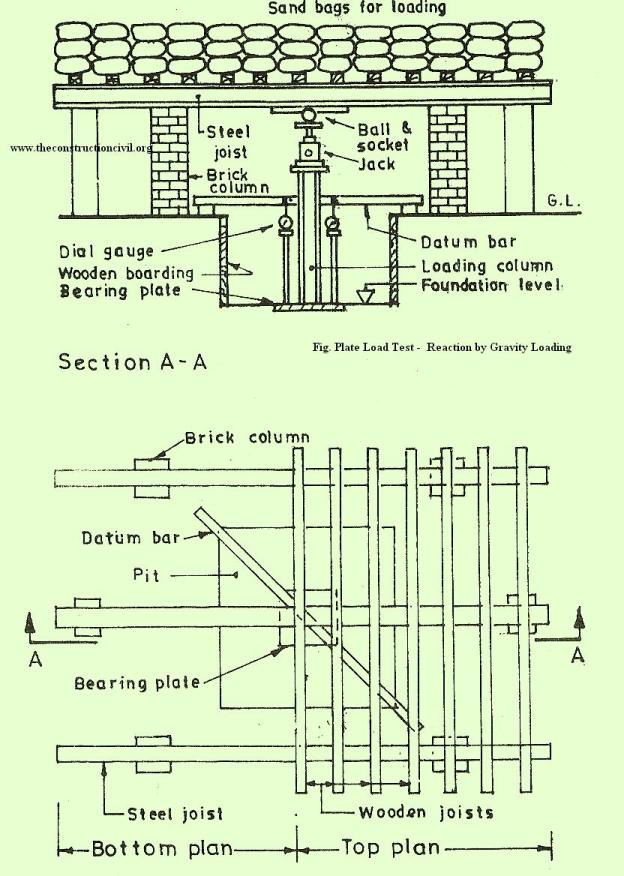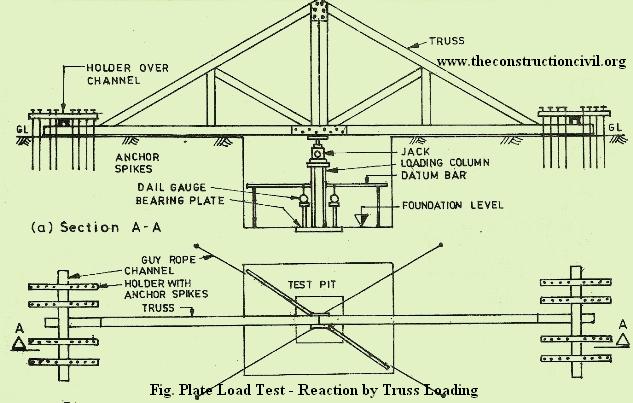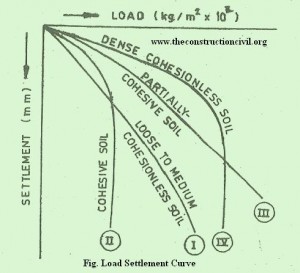Plate Load Test
Plate Load Test is a field test for determining the ultimate bearing capacity of soil and the likely settlement under a given load. The Plate Load Test basically consists of loading a steel plate placed at the foundation level and recording the settlements corresponding to each load increment. The test load is gradually increased till the plate starts to sink at a rapid rate. The total value of load on the plate in such a stage divided by the area of the steel plate gives the value of the ultimate bearing capacity of soil. The ultimate bearing capacity of soil is divided by suitable factor of safety (which varies from 2 to 3) to arrive at the value of safe bearing capacity of soil. For better understanding, this Plate Load Test can be sub-divided into the following heads,
1. Test set-up
2. Testing procedure
3. Interpretation of results
4. Limitations of the test.
1. Test Setup:
A test pit is dug at site up to the depth at which the foundation is proposed to be laid. The width of the pit should be at least 5 times the width of the test plate. At the centre of the pit a small square depression or hole is made whose size is equal to the size of the test plate and bottom level of which corresponds to the level of actual foundation. The depth of the hole should be such that the ratio of depth to width of the loaded area is approximately the same as the ratio of the actual depth to width of the foundation.
The mild steel plate (also known as bearing plate) used in the test should not be less than 25 mm in thickness and its size may vary from 300 to 750 mm. The plate could be square or circular in shape. Circular plate is adopted in case of circular footing and square plate is used in all other types of footings. The plate is machined on side and edges.
2. Testing Procedure:
The load is applied to the test plate through a centrally placed column. The test load is transmitted to the column by one of the following two methods
(i) By gravity loading or reaction loading method
(ii) By loading truss method.
(i) Gravity loading or reaction loading method:
In case of gravity loading method, a loading platform is constructed over the column placed on the test plate and test load is applied by placing dead weight in the form of sand bags, pig iron, concrete blocks, lead bars etc. on the platform. Many a times a hydraulic jack is placed between the loading platform and the column top for applying the load to the test plate – the reaction of the hydraulic jack being borne by the loaded platform. This form of loading is termed as reaction loading.

(ii) Reaction Truss Method:
In case of reaction truss method, instead of constructing a loading platform, a steel truss of suitable size is provided to bear the reaction of the hydraulic jack. The truss is firmly anchored to the ground by means of steel anchors and guy ropes are provided for ensuring its lateral stability. When the load is applied to the test plate, it starts sinking slowly. The settlement of the plate is recorded to an accuracy of 0.02 mm with the help of sensitive dial gauges. At least two dial gauges are used to account for differential settlement. The dial gauges are placed at diametrically opposite ends of the plate and one dial gauge is mounted on independently supported references beam or datum rod. As the plate sinks, the ram of the dial gauge moves down and the settlement is recorded. The magnitude of load is indicated on the load-gauge of the hydraulic jack. The load is applied in regular increment of about 2KN or 1/5th of the expected ultimate bearing capacity, whichever is less. Settlement should be observed for each increment of load after an interval of 1, 4, 10, 20,
40 and 60 minutes and thereafter at hourly intervals until the rate of settlement becomes less than 002 mm per hour. The maximum load to be applied for the test should be about 15 times the expected ultimate bearing capacity of the soil.
In case of clayey soils the, time settlement curve should be plotted at each load stage and load should be increased to next stage either when the curve indicates that the settlement has exceeded 70 to 80% of the probable ultimate settlement at that stage or at the end of 24 hour period.

For soils other than clayey soils, each load increment should be kept for not less than one hour or upto a time when the rate of settlement gets appreciably reduced (to a value of 0.02 mm per mm.). The next increment of load should then be applied and observations repeated. The test is continued till a settlement of 25 mm under normal circumstances or 50 mm in special cases (such as dense gravel, and sand mixture) is obtained or till failure occurs, whichever is earlier.
3. Interpretation of Results:
The load intensity and settlement observations of the plate load test are plotted in the form of load settlement curves.

The figure below shows four typical curves applied to different soils.
Curve I is typical for loose to medium non.cohesive soils. It can be seen that initially this curve is a straight line, but as the load increases it flattens out. There is no clear point of shear failure.
Curve II is typical for cohesive soils. This may not be quite straight in the initial stages and leans towards settlement axis as the settlement increases.
Curve III is typical for partially cohesive soils.
Curve IV is typical for purely dense non-cohesive soil.
The safe bearing capacity is obtained by dividing the ultimate bearing capacity by a factor of safety varying from 2 to 3. The value of safe bearing capacity thus arrived at, is considered to be based on criterion of shear failure.
Safe bearing capacity (SBC) based on permissible settlement. As indicated earlier the settlement of footing is also related to the SBC of the soil. The value of ultimate bearing capacity and hence the SBC in this case, can be obtained from the load settlement curves by reading the value of load intensity corresponding to the desired settlement of test plate. The value of permissible settlement (Sf) for different types of footings (isolated or raft) for different types structures are specified in the l.S. code. The corresponding settlement of test plate (Sp) can be calculated from the following formula,
Sf = Sp {[B (Bp + 0.3) ]/[ Bp (B + 0.3) ]}^2
Where,
B = width of footing in mm.
Bp = width of test plate in mm.
Sp= settlement of test plate in mm.
Sf = settlement of footing in mm.
4. Limitations of plate load test:
The plate load test, though very useful in obtaining necessary information about soil for design of foundation has following limitations,
(1) The test results reflect only the character of the soil located within a depth of less than twice the width of bearing plate. Normally the foundations are larger than the test plates, the settlement and shear resistance of soil against shear failure will depend on the properties of much thickea stratum. Thus the results of test could be misleading if the character of the soil changes at shallow depths.
(ii) The Plate Load Test being of short duration, does not give the ultimate settlements particularly in case of cohesive soils.
(iii) For clayey soils the bearing capacity (from shear consideration) for a large foundation, is almost same as that for the smaller test plate. But in dense sandy soils the bearing apacity increases with the size of the foundation and hence the test with smaller size test plate tends to give conservative values in dense sandy soils.
In view of the above limitations, the plate load test method of determining SBC of soil may be considered adequate for light or less important structures under normal condition. However, in case of unusual type of soil stratum and for all heavy and important structures, relevant laboratory tests or field test are essential to establish the SBC of soil.
